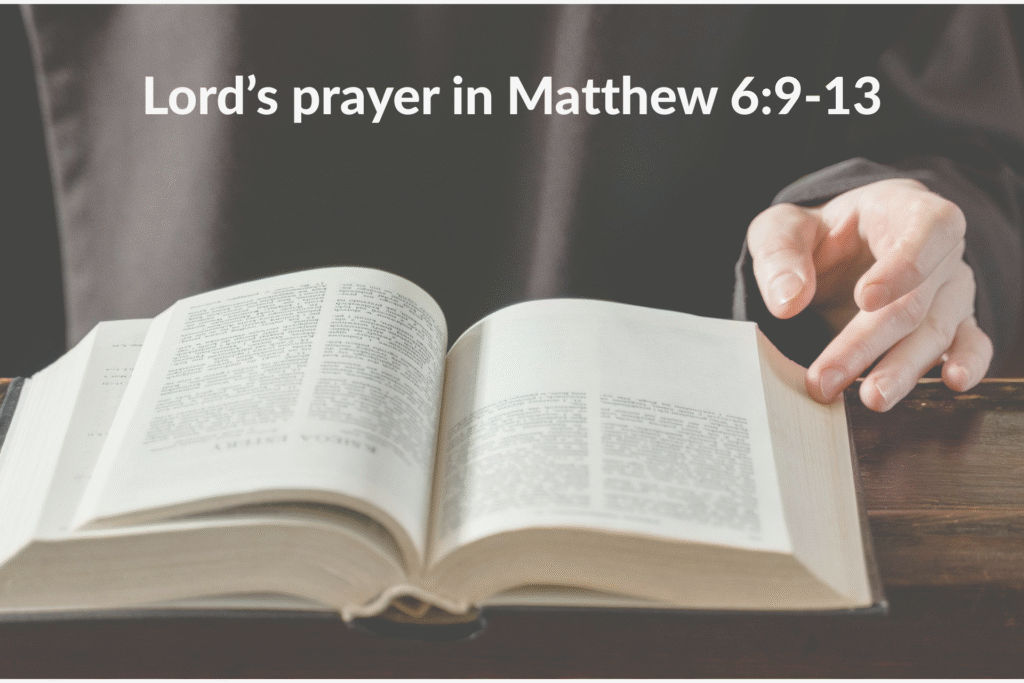
The Lord’s Prayer, also known as the “Our Father” or the “Father’s Prayer,” is one of the most widely recognized and spoken prayers within Christianity. Appearing in the Gospels of Matthew and Luke, this profound and straightforward prayer was presented by Jesus when His disciples asked how they should pray. Through it, Jesus offers a timeless blueprint for connecting with God. In this article, we’ll examine different translations, unpack their deeper significance, and explore the key lessons they offer.
1. Introduction to The Lord’s Prayer
Known as the Our Father, the Lord’s Prayer is a beloved Scripture passage in Matthew and Luke. Jesus taught it to His disciples as a foundational way to pray. It opens with “Our Father in heaven,” showing reverence for God’s holiness and position in our lives. It continues with a plea for “daily bread,” representing our daily reliance on God for both physical needs and spiritual strength. Though brief, the prayer reshapes how we see the world—centring life around God, His will, and His provision.
2. Jesus’ Teachings on Prayer
Jesus encouraged His disciples to pray with persistence and sincere faith. He used the parable of a friend who rises late at night to help another friend, demonstrating that persistent requests are heard. He also warned against performative prayer, stressing that prayer should be private and heartfelt. God already knows our needs—He desires authentic hearts, not public displays. The emphasis is on genuine connection with God, not outward appearances.
3. The Traditional Lord’s Prayer
The traditional version remains widely prayed today. Here is how it is often recited:
Our Father, who art in heaven,
Hallowed be thy name;
Thy kingdom come;
Thy will be done;
On earth as it is in heaven.
Give us this day our daily bread.
And forgive us our trespasses,
As we forgive those who trespass against us.
And lead us not into temptation,
But deliver us from evil.
For thine is the kingdom, the power, and the glory,
For ever and ever. Amen.
This version is revered for its poetic and sacred tone, often committed to memory for daily reflection and connection with God.
4. The Contemporary Lord’s Prayer
Modern translations offer a more relatable version for today’s reader:
Our Father in heaven,
Hallowed be your name,
Your kingdom come,
Your will be done,
On earth as in heaven.
Give us today our daily bread.
Forgive us our sins
As we forgive those who sin against us.
Lead us not into temptation
But deliver us from evil.
For the kingdom, the power,
And the glory are yours,
Now and forever. Amen.
This version retains the message’s power while using accessible language. It invites us to honor God, trust His care, seek forgiveness, and affirm His eternal authority.
5. The Lord’s Prayer in the Bible
Matthew 6:9-13
“This, then, is how you should pray:
‘Our Father in heaven, hallowed be your name, your kingdom come, you will be done, on earth as it is in heaven. Give us today our daily bread. And forgive us our debts, as we also have forgiven our debtors. And lead us not into temptation, but deliver us from the evil one.’”
Luke 11:2-4
“He said to them, ‘When you pray, say: Father, hallowed be your name, your kingdom come. Give us each day our daily bread. Forgive our sins, for we also forgive everyone who sins against us. And lead us not into temptation.’”
These verses present two accounts of the prayer. Matthew offers a fuller version, while Luke provides a shorter one. Both share a consistent message: honor God, seek His will, ask for provision, and practice forgiveness.

“This then is how you should pray:
‘Our Father, who art in heaven,
hallowed be thy name;
thy kingdom come;
thy will be done;
on earth as it is in heaven.
Give us this day our daily bread.
And forgive us our trespasses,
as we forgive those who trespass against us.
And lead us not into temptation;
but deliver us from evil.
For thine is the kingdom,
the power and the glory,
for ever and ever.
Amen.’” (Matthew 6:9-13)
6. Different Translations of the Lord’s Prayer
King James Version (KJV)
The Message Version
Our Father in heaven,
Reveal who you are.
Set the world right;
Do what’s best—
as above, so below.
Keep us alive with three square meals.
Keep us forgiven with you and forgiving others.
Keep us safe from ourselves and the Devil.
You’re in charge!
You can do anything you want!
You’re ablaze in beauty! Yes. Yes. Yes.
This elegant translation from the KJV is cherished for its rich, poetic language. It has long been a source of spiritual comfort and reverence for believers.
7. The Lord’s Prayer for Kids
Here’s a child-friendly version of the prayer:
Dear God, our Father in heaven,
Your name is special and holy.
We want to be with you in heaven,
And for what you want to be done on earth, just like in heaven.
Please give us what we need each day.
Forgive us for the wrong things we do,
Help us to forgive people who do wrong to us.
Help us to make good choices,
And keep us safe from evil.
We know you are powerful forever and ever. Amen.
This paraphrased translation offers a conversational approach, expressing the core ideas in contemporary language. It emphasizes God’s relationship with us and His beauty and power.
8. Thy Kingdom Come
This line holds a two-fold meaning. It expresses our hope that God’s reign becomes evident here and now, leading to a world defined by love, faith, and hope (1 Corinthians 13:13). It is a plea for justice, peace, and divine rule on earth. Praying this means we are welcoming God’s perfect will to shape our lives and the world around us.
9. God’s Kingdom and Our Lives
The prayer for “daily bread” refers not only to physical nourishment but also to spiritual sustenance. It’s often interpreted as “supersubstantial bread”—food for eternal life in God’s Kingdom. Asking for God’s Kingdom to come commits us to live in alignment with His will. It calls us to pursue lives defined by grace, faith, and compassion, and to reflect God’s values in our world.
10. The Deeper Meaning of the Lord’s Prayer
God as Our Father: Verses like Galatians 4:4-7 and Romans 8:14-17 highlight how, through Christ, we are adopted as God’s children. Addressing God as “Father” indicates an intimate, trusting relationship.
Daily Bread as Spiritual Nourishment: In John 6:27-58, Jesus describes Himself as the “bread of life,” revealing that the prayer’s request is for eternal sustenance, not just physical food.
11. How the Lord’s Prayer Guides Us in Prayer
The Lord’s Prayer is more than a recitation—it’s a guide. Jesus teaches us to begin with reverence, align with God’s purposes, confess our needs and sins, and seek strength. It’s a complete model that invites a deeper, more honest relationship with God, covering every aspect of a believer’s walk with Him.
12. Conclusion: A Timeless Model of Prayer
The Lord’s Prayer is not only a beautiful expression of devotion but a powerful tool for everyday spiritual connection. It offers balance—worship, trust, repentance, and hope. Whether you’re beginning your faith journey or have been praying for years, this prayer remains a reliable guide for deepening your relationship with God.
6 Key Lessons from the Lord’s Prayer
- Addressing God as Father: Highlights trust and closeness with God.
- Worshiping God’s Name: Reminds us of His holiness and our awe.
- Submitting to God’s Will: Teaches surrender and faith in His plans.
- Asking for Daily Needs: Acknowledges our constant dependence on Him.
- Seeking Forgiveness and Offering it: Encourages grace and healing.
- Protection from Temptation and Evil: Calls for God’s guidance and strength.